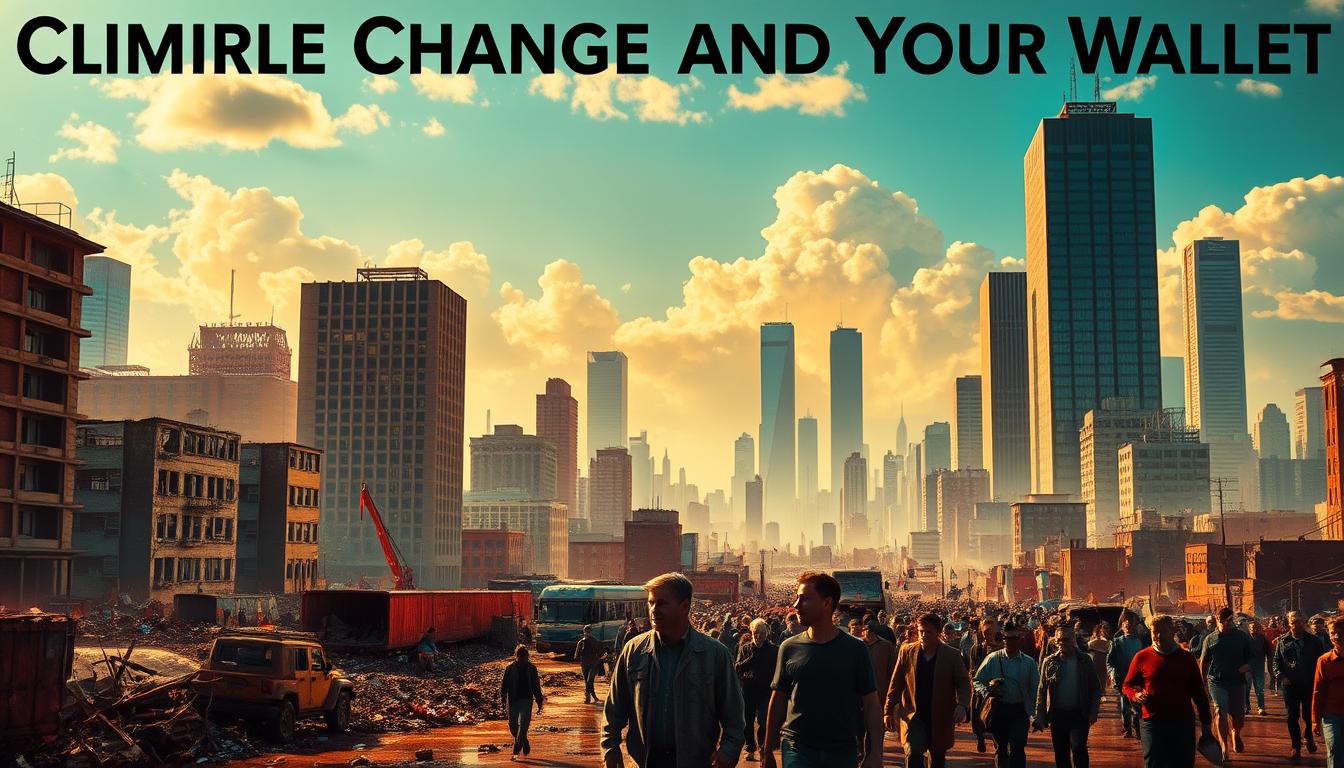The effects of climate change are not just environmental; they also have a significant impact on your personal finances. Rising temperatures and extreme weather events can lead to increased costs in various aspects of your life, from insurance premiums to daily expenses.

Understanding the financial implications of climate change is crucial for making informed decisions about your money. As climate-related events become more frequent and severe, their economic impact will only continue to grow.
Key Takeaways
- The financial impact of climate change affects individuals in various ways.
- Rising insurance costs are a significant consequence of climate-related events.
- Climate change influences daily expenses and long-term financial planning.
- Understanding climate change costs can help in making informed financial decisions.
- Preparing for climate-related financial impacts is essential for financial stability.
Climate Change and Your Wallet: An Overview
As the world grapples with the realities of climate change, its impact on personal finances is becoming increasingly evident. The economic threat posed by climate change is not just a distant concern; it’s a current reality that affects individuals, businesses, and governments alike.
The Growing Economic Threat
Climate change is escalating the frequency and severity of extreme weather events, from hurricanes to wildfires. According to a report by the Intergovernmental Panel on Climate Change (IPCC), the economic losses from these events are projected to increase significantly. For instance, in the United States alone, the total economic loss from climate-related disasters exceeded $300 billion between 2017 and 2018.
How Climate Risks Translate to Financial Costs
Climate-related risks translate into financial costs through various channels. For example, damage to infrastructure, increased healthcare costs due to heatwaves and poor air quality, and losses in agriculture and forestry all contribute to the economic burden. A study by the Economist Intelligence Unit found that climate change could reduce global GDP by up to 11% by 2100 if left unchecked.
| Economic Sector | Climate-Related Risk | Potential Financial Impact |
|---|---|---|
| Agriculture | Crop failures, livestock losses | Reduced income for farmers, increased food prices |
| Infrastructure | Damage from extreme weather events | High repair and reconstruction costs |
| Healthcare | Increased incidence of heat-related illnesses | Higher medical costs, lost productivity |
As the data illustrates, the financial implications of climate change are far-reaching and multifaceted. Understanding these risks is the first step towards mitigating their impact on personal finances.
“The economic risks of climate change are not just a future threat; they are a current reality that demands immediate attention and action.”
No author
Rising Insurance Premiums in a Warming World
In a world grappling with climate change, one of the most immediate financial consequences is the increase in insurance premiums. As extreme weather events become more frequent and intense, the insurance industry is faced with rising costs, which are then passed on to consumers.
This trend is particularly concerning for homeowners and businesses in high-risk areas, who are already struggling with the financial impacts of climate change. According to recent studies, climate-related disasters have led to significant increases in insurance claims, driving up premiums across the board.
Home Insurance Rate Hikes in High-Risk Zones
Homeowners in areas prone to natural disasters, such as hurricanes, wildfires, and floods, are experiencing significant rate hikes. For instance, a report by the National Association of Insurance Commissioners found that homeowners insurance premiums rose by 10% between 2018 and 2019, with much of this increase attributed to climate-related risks.
The impact is most pronounced in regions that are repeatedly hit by severe weather events. As
“The increasing frequency and severity of natural disasters are redefining the insurance landscape, making it imperative for homeowners to reassess their risk exposure and insurance coverage.”
said by an insurance expert.
Auto and Health Insurance Cost Increases
The effects of climate change are not limited to home insurance. Auto insurance premiums are also rising, particularly in areas where extreme weather events are common. Moreover, health insurance costs are increasing due to the growing incidence of climate-related health issues, such as heat stress and respiratory problems.
Flood Insurance Challenges
Flood insurance poses a unique challenge, especially for those living in flood-prone areas. The National Flood Insurance Program (NFIP) has faced financial strain due to the rising number of flood claims. As a result, flood insurance premiums are expected to rise, further burdening homeowners in vulnerable regions.
In conclusion, the rising insurance premiums in a warming world are a pressing concern that requires immediate attention. As climate change continues to intensify, it is crucial for individuals and businesses to stay informed and adapt their insurance strategies accordingly.
Real Estate Values and Climate Vulnerability
Climate vulnerability is redefining the real estate landscape, affecting property values across the United States. As the frequency and severity of climate-related events increase, certain regions are becoming less desirable, impacting local real estate markets.
Coastal and Wildfire-Prone Property Devaluation
Properties located in coastal areas and wildfire-prone regions are experiencing significant devaluation due to the heightened risk of climate-related disasters. For instance, a study by First Street Foundation found that properties in flood-prone areas could lose up to 25% of their value by 2050.
Climate Gentrification in American Cities
Conversely, some neighborhoods are becoming more desirable due to their relative safety from climate impacts, a phenomenon known as climate gentrification. This shift is leading to increased property values in these areas, as seen in cities like Miami, where higher elevation neighborhoods are becoming more attractive.
Mortgage Lending Changes in High-Risk Areas
Mortgage lenders are also adapting to climate risks by tightening lending standards in high-risk areas. This change can affect the availability of credit for homebuyers in vulnerable regions, further influencing local real estate markets.
| Region | Projected Property Value Change by 2050 | Climate Risk Factor |
|---|---|---|
| Coastal Areas | -15% to -25% | Flood Risk |
| Wildfire-Prone Zones | -10% to -20% | Wildfire Risk |
| High Elevation Neighborhoods | +5% to +10% | Relative Safety |
“The impact of climate change on real estate is not just about rising sea levels; it’s about the economic and social implications of a changing climate on property values.” –
Dr. Susana B. Adamo, Climate Change Expert
Everyday Budget Impacts: Food and Utilities
As climate change intensifies, its effects on our everyday budgets are becoming harder to ignore, especially in terms of food and energy expenses. The ripple effects of climate change are being felt across various sectors, with the agricultural industry being particularly vulnerable.
Agricultural Disruptions and Grocery Bills
Climate-related disruptions to agriculture are leading to crop failures, reduced yields, and changed growing seasons. This, in turn, results in higher production costs and, ultimately, higher prices for consumers at the grocery store. For instance, extreme weather events like droughts and floods can devastate crops, leading to shortages and price hikes for staple foods.
Energy Costs During Extreme Weather Events
Extreme weather events, such as heatwaves and cold snaps, cause energy costs to spike as households increase their use of heating or cooling. This surge in energy demand can strain the grid, leading to higher costs for consumers. Moreover, the increased frequency and severity of these events are making it more challenging for households to budget for energy expenses.
Water Bills in Drought-Prone Regions
In regions experiencing drought, water scarcity can lead to higher water bills as conservation measures are implemented. For example, some cities have introduced tiered pricing for water, where higher rates are charged for excessive water use.

| Category | Climate-Related Impact | Financial Impact |
|---|---|---|
| Food | Crop failures, reduced yields | Higher grocery bills |
| Energy | Extreme weather events | Increased energy costs |
| Water | Drought, water scarcity | Higher water bills |
Healthcare Costs Driven by Environmental Changes
As the planet warms, the financial strain on healthcare due to climate-related illnesses is escalating. Climate change is no longer just an environmental issue; it’s a growing healthcare concern that affects us all. Rising temperatures and extreme weather events are directly linked to increased hospital visits, medical expenses, and lost productivity.
Respiratory Illness Expenses from Poor Air Quality
Poor air quality, exacerbated by climate change, leads to increased cases of respiratory illnesses such as asthma. The medical costs associated with treating these conditions are significant, placing a heavy burden on both families and the healthcare system. In areas prone to wildfires or high levels of pollution, these costs can be particularly high.
Moreover, the indirect costs, such as lost productivity due to illness, further compound the financial impact. As air quality worsens, so does the economic strain on communities.
Heat-Related Medical Costs and Productivity Loss
Heat-related illnesses are another significant concern. As temperatures rise, so do the instances of heatstroke, dehydration, and other heat-related conditions. The costs of treating these illnesses are substantial, and when combined with the loss of productivity, they represent a considerable economic burden.
Workers in outdoor industries, such as construction or agriculture, are particularly vulnerable. The financial impact extends beyond the individual, affecting businesses and the broader economy as well.
In conclusion, the healthcare costs driven by environmental changes are multifaceted, affecting individuals, the healthcare system, and the economy at large. Understanding these impacts is crucial for developing strategies to mitigate them.
Employment and Income Security Challenges
As the effects of climate change intensify, employment and income security are becoming increasingly vulnerable to environmental disruptions. Rising temperatures and extreme weather events are altering the job landscape, affecting various industries and occupations.
Vulnerable Industries and Job Losses
Industries closely tied to natural resources, such as agriculture, forestry, and fishing, are particularly susceptible to climate-related disruptions. For instance, changing weather patterns can lead to crop failures, reduced fisheries, and increased risk of wildfires, potentially resulting in job losses. According to the International Labor Organization (ILO), climate change could lead to the loss of millions of jobs globally by 2030.
| Industry | Climate-Related Risk | Potential Job Impact |
|---|---|---|
| Agriculture | Droughts, floods, heatwaves | Crop failure, reduced productivity |
| Forestry | Wildfires, changing tree species | Job losses in forest management |
| Fishing | Ocean acidification, changing fish stocks | Reduced fisheries, job insecurity |
Green Economy Opportunities and Career Transitions
While climate change poses significant challenges, it also creates opportunities in the green economy. Emerging sectors such as renewable energy, sustainable infrastructure, and eco-tourism are generating new job prospects. Workers can transition into roles like solar panel installers, wind turbine technicians, and sustainability consultants, leveraging their skills in environmentally beneficial ways.

Financial Protection Strategies for Climate Resilience
Building financial resilience against climate change involves a multifaceted approach that includes insurance, investments, and home improvements. As the frequency and severity of climate-related events continue to rise, individuals must adapt their financial strategies to mitigate potential losses.
Insurance Portfolio Optimization
Optimizing your insurance portfolio is crucial for financial protection. This involves reviewing your current policies to ensure they provide adequate coverage against climate-related risks. For instance, homeowners in flood-prone areas should consider purchasing flood insurance to protect their properties.
Climate-Smart Investment Approaches
Investing in climate-resilient infrastructure and green technologies can yield long-term financial benefits. As Mark Carney, former Governor of the Bank of England, noted, “The financial system has a critical role to play in addressing climate change.” Diversifying your investments to include climate-smart assets can help safeguard your financial future.
Home Improvements for Weather Resilience
Making your home more resilient to extreme weather events can significantly reduce potential damages. Simple measures like installing storm shutters, reinforcing roofs, and improving drainage systems can make a substantial difference.
Emergency Fund Planning for Climate Disasters
Having an emergency fund in place is vital for covering unexpected expenses related to climate disasters. Experts recommend saving three to six months’ worth of living expenses in an easily accessible savings account.
By implementing these financial protection strategies, individuals can enhance their resilience to climate change and safeguard their financial well-being.
Conclusion: Safeguarding Your Financial Future in a Changing Climate
As we’ve explored, climate change has far-reaching implications for personal finances, from rising insurance premiums to impacts on real estate values and everyday expenses. Understanding these risks is crucial for effective climate change financial planning.
To protect your financial well-being, it’s essential to stay informed about climate-related risks and take proactive steps. This includes optimizing your insurance portfolio, adopting climate-smart investment strategies, and making weather-resilient home improvements.
By taking these measures, you can enhance your financial resilience to climate change and contribute to a more sustainable future. Effective safeguarding of your financial future in a changing climate requires ongoing vigilance and adaptation.
As you move forward, consider how climate change financial planning can be integrated into your overall financial strategy, ensuring you’re prepared for the challenges ahead.
FAQ
How does climate change affect insurance premiums?
Climate change leads to rising insurance premiums due to increased frequency and severity of natural disasters, causing insurers to raise rates to cover potential losses.
What is climate gentrification, and how does it impact real estate values?
Climate gentrification refers to the phenomenon where neighborhoods that are relatively safe from climate impacts become more desirable, leading to increased property values, while areas prone to climate-related hazards experience devaluation.
How do extreme weather events influence energy costs?
Extreme weather events, such as heatwaves and cold snaps, lead to spikes in energy costs as households and businesses consume more energy to maintain comfortable temperatures, resulting in higher utility bills.
What are the financial implications of climate-related health issues?
Climate-related health issues, such as respiratory illnesses and heat-related conditions, result in increased healthcare costs, lost productivity, and other financial burdens on individuals and the healthcare system.
How can individuals protect their finances from climate-related risks?
Individuals can protect their finances by optimizing their insurance portfolios, adopting climate-smart investment approaches, making home improvements to enhance weather resilience, and maintaining emergency funds to cover climate-related disasters.
What are the employment and income security challenges posed by climate change?
Climate change poses employment and income security challenges, particularly in industries vulnerable to climate-related disruptions, such as agriculture, forestry, and tourism, while also creating opportunities in the green economy.
How does climate change impact food prices and grocery bills?
Climate-related disruptions to agricultural production lead to crop failures, reduced yields, and changed growing seasons, resulting in higher food prices and increased grocery bills.
What is the impact of climate change on mortgage lending practices?
Climate change is influencing mortgage lending practices, with lenders increasingly considering climate-related risks when evaluating loan applications, particularly in high-risk areas, such as flood-prone zones.






